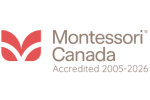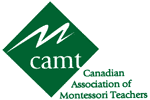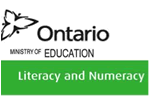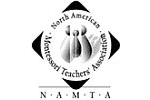Boardwalk Montessori School is an Accredited Member School of Montessori Canada, demonstrating a commitment to high-quality Montessori education.
1. The “Whole Child” Approach
The primary goal of a Montessori program is to help each child reach full potential in all areas of life. Activities promote the development of social skills, emotional growth, and physical coordination as well as cognitive skills. Under the direction of a specially trained teacher, the holistic curriculum allows the child to experience the joy of learning, gives the child time to enjoy the process, ensures the development of self-esteem, and provides the experiences from which children create their knowledge.
2. The “Responsive, Prepared, Adaptive Environment”
In order for self-directed learning to take place, the whole learning environment – facilities, room, materials, social climate, and experiences – must be supportive of the learner. The teacher provides necessary resources, including opportunities for children to function in a safe and positive climate.
An atmosphere of support and trust enables the children to explore and discover confidently.
3. Mixed Age Groupings
The multi-age grouping in each class provides a family-like setting where learning can take place naturally. More experienced children share what they have learned while reinforcing their own knowledge and skills. The multi-age community interaction is intrinsic to Montessori. This encourages rich language experiences, and opportunities for the development of empathy and social learning.
In order to respond to the diversity of individual children’s developmental needs, classes in the Casa group children across a three-year age span. Toddler programs may have a one year age span in order to comply with Ministry guidelines and/or the individual school’s programing.
Learning with and from each other to develop the social skills that form a class community. The social setting is like that of an extended family. The emergent skills of the individual children come together to form the class community.
4. Co-operation and Collaboration
Children are encouraged to respect and support one another in their learning, and with their daily needs and experiences. Learning is a social process.
5. The Montessori Materials
Dr. Montessori’s scientific observations of the children led her to design a number of multisensory, sequential, and self-correcting materials. These facilitate learning which builds from the concrete to the abstract in constructing their knowledge.
6. Self-Directed Learning
Children are free to work at their own pace with materials they have chosen, either alone or with others. The teacher relies on his or her observations of the children to determine which new activities and materials may be introduced to an individual child or to a small or large group. The aim is to encourage active, self-directed learning and to strike a balance of individual mastery with small group collaboration within the whole group community.
7. Freedom within Limits
Each Montessori class, from toddlers through elementary, operates on the principle of freedom within limits. Every program has its set of ground rules which differ from age to age, but is always based on core Montessori beliefs – respect for each other and for the environment.
8. The Teacher
Originally called a “Directress”, the Montessori teacher functions as designer of the environment, resource person, role model, demonstrator, record keeper, and meticulous observer of each child’s behaviour and growth.
The teacher acts as a facilitator of learning. This extensive training includes supervised classroom practice teaching and is specialized for the age group with which a teacher will work, i.e., toddler, 3 to 6 year olds.





